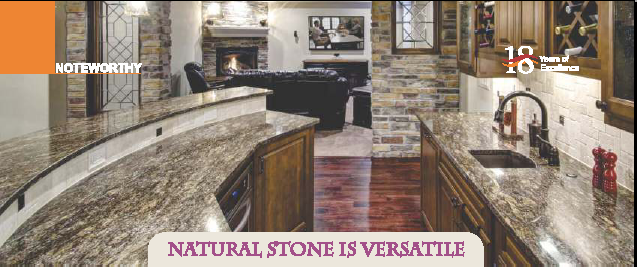Natural Stone is Versatile
 Author: STC
Author: STC
Article Date: 01.04.2016
India's history, dating back to 3200 BC has been influenced considerably by the disposition, development and use of stones and other construction materials. Dimension stones have also left deep imprints on the architectural heritage of the country.
Innumerable temples, forts and palaces of Ancient Indian Civilization have been carved out of locally available stones. The Taj Mahal at Agra was constructed from Indian marble. Some of the rock-cut structures include Khajuraho Temple, Elephanta Caves, and Konark Temple. Besides, all major archeological excavations have revealed exquisitely carved statue and carvings in stone. Ancient Buddhist monuments like the Sanchi Stupa of 3rd century BC have also been carved out of stone.
The tradition of Stone Architecture has continued to the present era, with most of the important modern buildings in India like the President House, Parliament House, and Supreme Court made from high quality sandstone of Rajasthan. The Bahai's House of Worship of New Delhi stands testimony to the relevance of marble in modern Indian architecture.
The characteristic configuration, simple geometric form of the Indian temple has increased structural strength against earthquake movements. Thoughtfully conceived design and constructional practices, which were executed with an extraordinary perfection, resulted in the creation of these everlasting, structurally sound structures, which have proved earthquake resistant to a considerable extent. The architectural heritage of India is full of possibilities which can provide the basis of inspiration for future requirements, if we can derive from them the fundamental aesthetical values and constructional techniques in building design which may sometimes be valid even today.
Stones are still the mainstays of civil construction in India, they are extensively used in public buildings, hotels, and temples. With the increase in penetration in middle class of India, stones are now widely used in construction of houses.
The Indian stone industry has evolved in terms of production and manufacturing of blocks, flooring slabs, structural slabs, calibrated - ready to fix tiles, monuments, tomb stones, sculptures, artifacts, cobbles, cubes, kerbs, pebbles and landscape garden stones.
Ceramic tiles which came in prominence about 20 years back have almost 85% of total tile consumption in the world. Natural stone contributed only about 15% of the total world consumption of 11,460 million sqm in 2014. Quartz Surfaces and other artificial stones have recently been made utilizing stones and other materials. They are becoming popular these days specially for kitchen countertops, flooring tiles and wall-cladding materials.
Architects, interior designers, builders, engineers and house owners should use natural stone as against other surfaces for the following reasons:
It is a great building product
It is both classic and contemporary
It is versatile and it is long lasting
It is easy to maintain and Although it is expensive, but its finish, natural beauty and colours are appealing.
A campaign for increasing use of natural stone is being launched in USA as "Genuine Stone". It is also referred as "Real Stone".
It is definite that natural stone would always find its place in temples, mosques, monuments and even prestigious buildings.